
Hooveria purpurea is a species of flowering plant related to the agaves known by the common name purple amole. This species of soap plant is endemic to California, where it grows in the Santa Lucia Range, in the Central Coast region. There are two varieties of this plant, and both are believed to be quite rare. It is a federally listed threatened species.
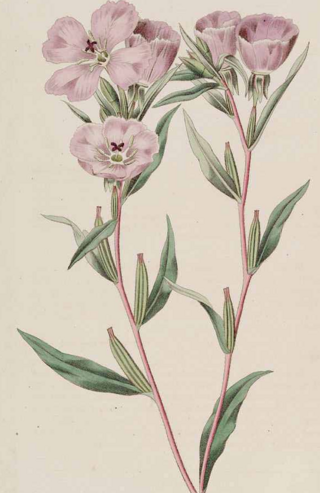
Clarkia purpurea is a species of wildflower known by the common names winecup clarkia, winecup fairyfan, and purple clarkia.
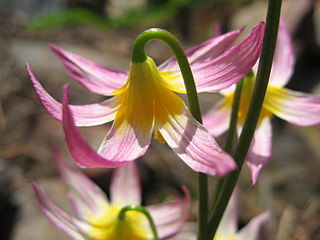
Erythronium purpurascens is a species of flowering plant in the lily family which is known by the common names purple fawn lily and Sierra Nevada fawn lily.

Fritillaria glauca is a species of fritillary known by the common names Siskiyou fritillary and Siskiyou missionbells.
Allium hoffmanii is a species of wild onion known by the common name beegum onion. It is native to northern California, where it grows in the serpentine soils of the local mountain ranges in Siskiyou, Humboldt, Trinity, Shasta, and Tehama Counties.
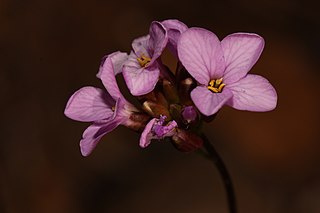
Arabis aculeolata is a species of flowering plant in the mustard family known by the common name Waldo rockcress.
Astragalus bicristatus is a species of milkvetch known by the common names crested milkvetch and two-crested milkvetch. It is endemic to southern California, where it grows in the coniferous forests of the San Gabriel and San Bernardino Mountains of the Transverse Ranges.
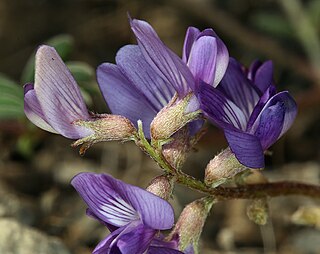
Astragalus inyoensis is a species of milkvetch known by the common name Inyo milkvetch.

Castilleja miniata is a species of Indian paintbrush known by the common name giant red Indian paintbrush. It is native to western North America from Alaska to Ontario to California to New Mexico, where it grows usually in moist places in a wide variety of habitat types.

Epilobium siskiyouense is a rare species of flowering plant in the evening primrose family known by the common names Siskiyou willowherb and Siskiyou fireweed.

Monardella douglasii is a species of flowering plant in the mint family known by the common name Douglas' monardella.

Monardella follettii is an uncommon species of flowering plant in the mint family known by the common name Follett's monardella.

Monardella breweri subsp. lanceolata, synonym Monardella lanceolata, is a species of flowering plant in the mint family. It is known by the common names mustang mint and mustang monardella. It is native to the mountains of California and Baja California, where it grows in chaparral, woodland, rocky slopes, and often disturbed habitat types.
Monardella linoides is a species of flowering plant in the mint family known by the common name flaxleaf monardella.
Monardella palmeri is a species of flowering plant in the mint family known by the common name Palmer's monardella.
Monardella sheltonii is a species of flowering plant in the mint family known by the common name Shelton's monardella.
Monardella stebbinsii is a rare species of flowering plant in the mint family known by the common names Feather River monardella and Stebbins' monardella. It is endemic to Plumas County, California, where it is known from only about ten occurrences along the North Fork of the Feather River in the High Sierra. It is a member of the serpentine soils flora in rocky mountain habitat.
Monardella stoneana is a rare species of flowering plant in the mint family known by the common name Jennifer's monardella.

Sanicula purpurea is a rare species of flowering plant in the carrot family known by the common names purple-flower black-snakeroot and purple-flowered sanicle. It is endemic to Hawaii, where it is known from Maui and from the Koolau Mountains on the island of Oahu. It is threatened by the degradation of its habitat. It was federally listed as endangered species of the United States in 1996.
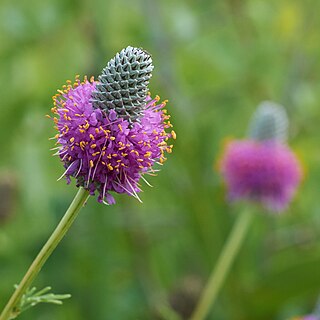
Dalea purpurea is a species of flowering plant in the legume family known as purple prairie clover. Native to central North America, purple prairie clover is a relatively common member of the Great Plains and prairie ecosystems. It blooms in the summer with dense spikes of bright purple flowers that attract many species of insects.













